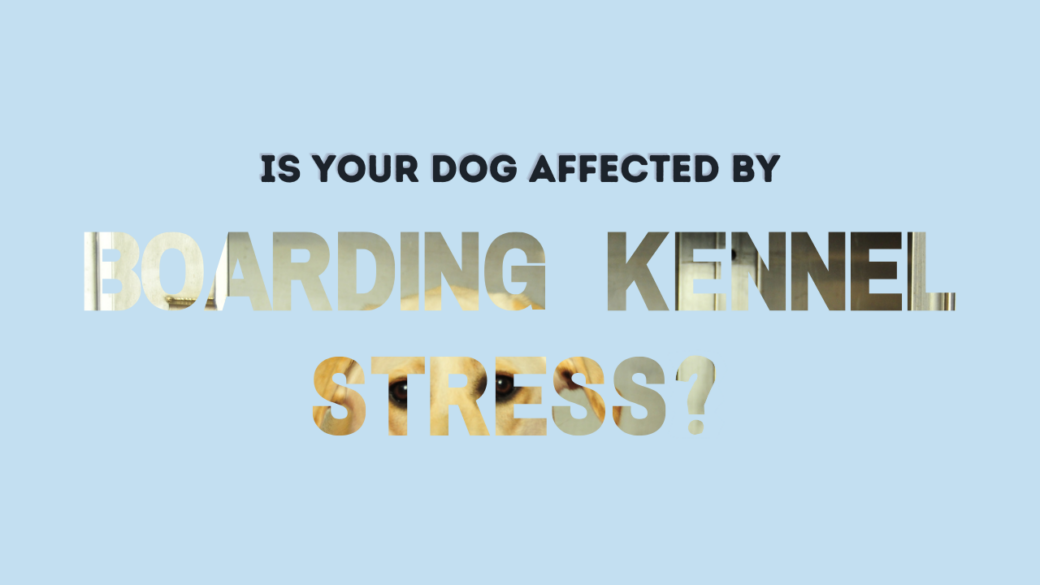The emotions and feelings of a dog can be quite obvious at times; a wagging tail when its owner returns home means happiness, while raised hackles at the sight of another dog is often interpreted as anger. However, there are times when a dog’s emotions will become more complex, and staying in a boarding kennel is one such example.
A boarding kennel usually disrupts the routine dogs have formed at home; this change, no matter how grand or slight, can cause dogs to become stressed and unsettled, especially nervous dogs. Their behaviour can change to include pacing, panting, and more. In boarding facilities, this has become known as “boarding kennel stress.”
But how do you know if your dog is experiencing this type of stress? This article aims to explain the signs of boarding kennel stress that dog owners and boarding staff should look out for, as well as the methods that are effective to help the dog cope.
Table of Contents
What is Boarding Kennel Stress?
Although primarily related to dogs in animal shelters and similar facilities, kennel stress can affect dogs housed in boarding kennels. It is commonly due to the disruption to their routine, which can cause anxiety and worry in dogs. When this happens, it becomes known as “boarding kennel stress.”
There are several stressors that could cause this, including crowding, continuous or loud noises, different food, routine changes, and unfamiliar people. Many boarding facilities take steps to reduce the stress dogs experience when staying with them, so this is a topic you should ask about when contacting and/or visiting kennels. If staff at a boarding kennel are unable to discuss the ways they ensure dogs stay calm and comfortable, then you should not proceed with that facility.
Unsurprisingly, anxious dogs are more likely to suffer from kennel stress due to their nature. These dogs often depend more on routine, so the smallest change can cause them to become stressed. On top of this, they will also be housed in close quarters with other dogs that might be experiencing the same emotions.
6 Signs of Kennel Stress Dogs Exhibit
Dogs, particularly anxious dogs, residing in boarding kennels might display one or more of the signs listed below.
Becoming more vocal
A dog suffering from boarding kennel stress might become increasingly vocal. Barking, crying, and howling are good indicators of a dog experiencing separation anxiety, which is one aspect of kennel stress. If it is due to separation anxiety, the barking or howling will stop as soon as the owner or another person the dog is comfortable with appears.
This sign of stress will be very distressing to other dogs in the boarding establishment, which can cause the situation to worsen. As multiple dogs will be kept in a boarding establishment at any one time, there is a higher chance of “contagious howling,” which happens when dogs become more vocal when they hear the sound of other canines. Understandably, this can be difficult to put a stop to.

Displaying aggression
Unfortunately, aggressive behaviour can be the result of kennel stress. A fearful dog will experience flight or fight, and fleeing is hardly an option in a confined space like a kennel. This is why a nervous dog in boarding facilities can develop aggressive behaviour; the animal views defensiveness as its best chance to protect itself.
Many dog boarding establishments will refuse to look after a dog that has acted aggressively towards people and other animals in the past, so it is essential that you let the staff know how your dog normally behaves. They should understand the signs showing a dog is purely reacting in response to stress and put practices in place to ease the dog’s tension.
Escaping or hiding
Although most reputable boarding kennels will have preventative measures in place, some dogs will work hard to escape unpleasant situations. Dogs have been known to dig under or climb fences and gates when boarded in an attempt to run away and find their way home; many kennels have learned about this habit and will utilise seamless units to stop this from happening, though.

Similarly, dogs will also seek out a secure hiding spot when they feel fear. Kennels that have been purpose-built for dogs will usually ensure dogs can hide in a sleeping area, which allows them to be hidden from other dogs and humans.
Losing its appetite
When there has been a change of routine, and the dog is now kept in unfamiliar surroundings, it isn’t unusual for the animal to turn its nose up at food. As the dog’s sympathetic nervous system, otherwise known as the fight or flight instinct, is activated, the dog cannot relax to eat, which means its appetite becomes suppressed.
Appetite loss can also happen when the boarding kennel serves the dog an unfamiliar brand or type of food.
Panting and lip-smacking
Although panting is commonly associated with excitement, heat, or thirstiness, stress can also cause dogs to display this behaviour. “Behaviour panting” is usually accompanied by hiding, lip-licking, pacing, shaking, whining, and yawning. Some of these other signs are used to self-soothe; for example, dogs will often lick their lips as a way to calm themselves down.
Shedding
Excessive shedding can be one of the first signs of stress. Many dog owners will be familiar with the flurry of fur that appears when visiting the vet, and a boarding kennel is just another environment that can cause this reaction. It’s currently unclear why stress triggers the release of hair in dogs, but it could be linked to adrenaline, which is one of the main stress hormones in canines.
Dogs might scratch themselves more often when they are anxious, too, which can cause loose hair to detach more easily.
If a dog displays one or a combination of these signs, it might stem from kennel stress. If this is the case, dog owners and boarding staff should know how to reduce the stress dogs might experience when kept in an animal boarding facility.
How to Reduce the Stress Experienced in Boarding Kennels
Kennel stress is more likely to affect nervous dogs, but there are steps you can follow to make the boarding experience easier for your four-legged friend. Although you can use these tips on adult dogs, they are also vital to follow if you own a puppy and plan on boarding it in the future.
Find boarding kennels for nervous dogs
There are some establishments that cater specifically to dogs that require a quieter and more personalised stay. This can include elderly and nervous dogs as well as dogs with additional needs. Boarding facilities that offer this type of accommodation will usually advertise it on their website or social media, but dog owners can also ask when contacting the establishment to check if it is licensed, etc.
In some instances, the boarders will also offer home boarding for dogs that fear the kennel environment. This helps to keep the dog in a home setting that is quieter and similar to their normal routine, which can benefit the dog’s well-being.

Let the kennel staff know the situation
Finding suitable dog boarding kennels for an anxious dog can be difficult, but a good way to start is by discussing your dog’s needs with the staff. In reputable kennels, the staff will be trained to care for all types of dogs, including breeds, sizes, as well as behaviours; as previously stated, however, some will refuse dogs that have been aggressive in the past.
Although the staff might not be able to guarantee the dog will receive the same amount of exercise it would get at home, you can try to request a certain amount of walks. Some kennels will work with local dog walkers to exercise the dogs in their care, although this might add an additional charge to the overall cost.
Before booking, ask the staff how they play and interact with the dogs that are boarded on the premises. Dogs require mental stimulation as well as exercise to stay content, and this can help the dog cope in an unfamiliar environment. To help the staff keep your pet happy, leave some of the dog’s favourite toys for during its stay.
Familiarise your dog with a crate
Anxious dogs can settle down quicker when they are kept in surroundings they have encountered before. Even though a crate isn’t the same as boarding kennels, the confinement is similar. It is often easier to begin crate training with young puppies, but it is possible to do this with an older dog, too.
There are different steps to follow when crate training a dog, such as:
- Get the dog used to the crate – Leave the crate open in a quiet room your dog has access to. Most dogs will begin to investigate the crate in their own time, going in and out as they choose to.
- Use the crate during feeding time – Feeding the dog in its crate will help to ensure the dog associates the crate with positive experiences. Once the dog is comfortable eating in the crate, you can close the door as they begin eating and open it before they finish the meal. You can also use a command, such as “crate,” to let them know when it is time to go to the crate.
- Close the door for longer periods – Once the dog shows no signs of stress at the door closing, you can extend the amount of time the door is closed. Increase this time slowly; the goal is for the dog to settle in the crate fully. If they begin to show signs of fear or anxiety, you will need to start over again, leaving the door open.
- Move away from the crate – If the dog is settled in the crate, you can take a few steps away before opening the door. You can increase the number of steps you take and the amount of time as long as the dog remains calm.
- Use the crate outside of feeding time – At this stage, the dog should be completely calm to lie in its crate as you move around the room. Use the command you have taught them and reward the behaviour frequently. Again, start with short periods in the crate, extending the time as long as the dog remains comfortable.
The well-being of your pets will benefit from this training when it comes to boarding them, as they will be familiar with the confinement.

Bring along home comforts
Dogs depend on routine, but this can be changed during boarding. One way to ease this discomfort is by surrounding them with familiar scents and sights. You can do this by taking along items from home to be kept in the kennel.
Some of the best objects to pack include your dog’s favourite toys and a piece of clothing or bedding that carries a familiar scent. Dog kennels generally accept these items, but boarding establishments will sometimes have a limit on the number of additional belongings each dog can have in its unit. This helps staff keep the kennels clean and tidy, and it also prevents the owner from losing important items.
As well as familiar items from home, you could pack a few puzzle games and treats for your dog. This will help provide mental stimulation when the dog is left alone in its kennel unit.
Start with an overnight stay
If you know that your dog is anxious in kennels, the best way to desensitise it to the environment is by slowly increasing the amount of time it spends there. Ensuring your dog stays in only for one night will limit the time it is left feeling anxious and stressed. You might find that your dog’s stay has been pleasant, meaning longer stays at the facility will not be an issue, but you must ensure the kennel staff report back to you upon collecting your pet.
A short stay is also the best choice when boarding puppies for the first time. Just as older dogs who have never experienced this environment will become stressed, puppies can experience this fear, too, especially as they will have experienced less socialisation at such a young age. If you own a puppy, discuss options with the boarding kennels’ staff to ensure its experience is controlled and enjoyable.
To Sum Up
Dog kennels will not cause all dogs to react fearfully, but some dogs will experience boarding kennel stress. If you own an anxious or nervous dog, it might be more likely to become uncomfortable in this environment. Although this can cause pet owners to cancel holiday plans, there are ways to ease the animal’s discomfort.
If you know your pet suffers from stress in boarding kennels, which will cause the dog to display specific signs, you and the boarding staff can try to make the dog’s stay more pleasant. The owners can begin crate training the dog before boarding, find a suitable boarding facility, and pack familiar items, while kennel staff can ensure the dog is exercised and mentally stimulated frequently.
Understanding the signs of boarding stress in dogs and knowing how to ease it will ensure dogs have a better experience when kept in kennels.

